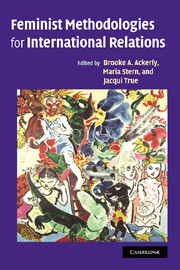Book contents
- Frontmatter
- Contents
- Notes on the contributors
- Acknowledgments
- 1 Feminist methodologies for International Relations
- Part I Methodological conversations between feminist and non-feminist IR
- Part II Methods for feminist International Relations
- 5 Motives and methods: using multi-sited ethnography to study US national security discourses
- 6 Methods for studying silences: gender analysis in institutions of hegemonic masculinity
- 7 Marginalized identity: new frontiers of research for IR?
- 8 From the trenches: dilemmas of feminist IR fieldwork
- 9 Racism, sexism, classism, and much more: reading security-identity in marginalized sites
- Part III Methodologies for feminist International Relations
- Conclusion
- Bibliography
- Index
6 - Methods for studying silences: gender analysis in institutions of hegemonic masculinity
Published online by Cambridge University Press: 12 January 2010
- Frontmatter
- Contents
- Notes on the contributors
- Acknowledgments
- 1 Feminist methodologies for International Relations
- Part I Methodological conversations between feminist and non-feminist IR
- Part II Methods for feminist International Relations
- 5 Motives and methods: using multi-sited ethnography to study US national security discourses
- 6 Methods for studying silences: gender analysis in institutions of hegemonic masculinity
- 7 Marginalized identity: new frontiers of research for IR?
- 8 From the trenches: dilemmas of feminist IR fieldwork
- 9 Racism, sexism, classism, and much more: reading security-identity in marginalized sites
- Part III Methodologies for feminist International Relations
- Conclusion
- Bibliography
- Index
Summary
Introduction
Institutions such as the military and state defense organization are central to the field of international relations. Simultaneously, they represent and reify specific gender relations. This chapter centers on methodological issues for feminist researchers interested in these institutions. They are institutions of hegemonic masculinity because male bodies dominate in them, and have done so historically, and a particular form of masculinity has become the norm (Connell 1995: 77). Although many institutions of importance to international relations can be categorized as institutions of hegemonic masculinity, the defense and military organizations have a particularly strong standing. The basis for my methodological reflections is a research puzzle aimed at mapping out and making sense of the gendered practices of the Swedish military and defense organization. Examples are given throughout from the study of military and defense institutions in Sweden. My approach starts from post-structural feminism and gives weight to structural components of gender relations, reproduced when individuals perform within institutions. It follows that I see institutions in general as important for understanding gender relations, but I have a particular interest in institutions of hegemonic masculinity. Apart from feminist IR work I have found much help in organizational studies dealing with gender and sexuality (Hearn and Parkin 2001; Wahl et al. 2001; Alvesson and Billing 1997; Hearn et al. 1989). Here I suggest that gender dynamics of these institutions be studied through analysis of documents, places and narratives.
- Type
- Chapter
- Information
- Feminist Methodologies for International Relations , pp. 108 - 128Publisher: Cambridge University PressPrint publication year: 2006
- 43
- Cited by



